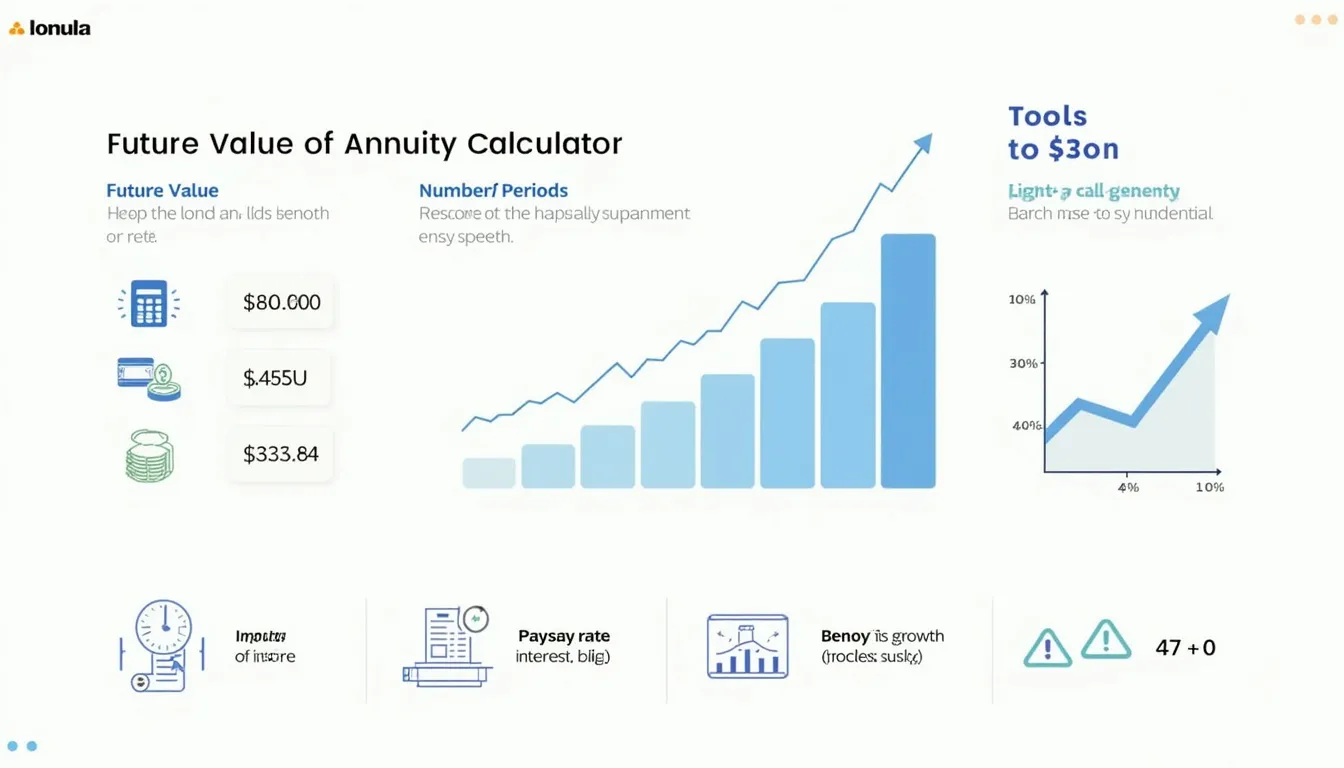Future Value of Annuity Due Calculator
Is this tool helpful?
How to use the tool
- Enter your periodic payment
• Example A: $650 each month.
• Example B: $900 each quarter. - Fill in the number of periods
• Example A: 240 months (20 years).
• Example B: 48 quarters (12 years). - Add the interest rate per period
• Example A: 0.5 % monthly (≈6 % nominal annual).
• Example B: 1.8 % quarterly (≈7.2 % nominal annual). - Select “Calculate.” The tool displays the future value in your currency.
- Compare scenarios. Adjust any field to see how payment size, length, or rate changes outcomes.
Formula the calculator uses
For a payment made at the beginning of each period:
$$ FV_{AD}=P \times \frac{(1+r)^{n}-1}{r}\times(1+r) $$- P = payment per period
- r = interest rate per period (decimal)
- n = number of periods
Example calculations
- Monthly plan (Example A)
$650 × rac{(1+0.005)^{240}-1}{0.005} × 1.005 ≈ $301 ,542. - Quarterly plan (Example B)
$900 × rac{(1+0.018)^{48}-1}{0.018} × 1.018 ≈ $69 ,066.
Quick-Facts
- Average U.S. savings rate: 0.45 % APR (FDIC.gov, 2024).
- IRA contribution cap 2024: $7,000 per year (IRS Pub 590-A, 2023).
- Annuity-due premium: ~5 % higher value than ordinary annuity at 5 % rate (Damodaran, 2020).
- TVM convention: Formula aligns with CFA Level I curriculum (CFA Institute, 2022).
FAQ
What is the future value of an annuity due?
It is the amount you will have when equal deposits made at each period’s start compound for n periods at rate r.
Why is an annuity due worth more than an ordinary annuity?
Each payment earns one extra period of interest, boosting the final sum by roughly (1 + r) times (Investopedia, “Annuity Due”).
Which rate should I enter—nominal or effective?
Enter the effective rate per period. Divide an annual nominal rate by payment frequency to approximate it (Federal Reserve, 2023).
Can I model annual inflation?
No. Subtract expected inflation from the nominal rate to input a real rate, then recalculate (BLS CPI FAQ, 2023).
Does the tool support irregular deposits?
No. The math assumes identical payments. Run separate calculations or use a spreadsheet for uneven schedules.
Is the calculation exact?
Yes for the stated inputs; actual returns vary with rate changes and taxes (SEC Investor Bulletin, 2022).
How do I compare two savings plans quickly?
Change one variable—rate, amount, or periods—while holding others constant and note the displayed difference.
Can I use other currencies?
Yes. The formula is currency-agnostic; ensure you keep the same currency for all inputs and interpretations.
Important Disclaimer
The calculations, results, and content provided by our tools are not guaranteed to be accurate, complete, or reliable. Users are responsible for verifying and interpreting the results. Our content and tools may contain errors, biases, or inconsistencies. We reserve the right to save inputs and outputs from our tools for the purposes of error debugging, bias identification, and performance improvement. External companies providing AI models used in our tools may also save and process data in accordance with their own policies. By using our tools, you consent to this data collection and processing. We reserve the right to limit the usage of our tools based on current usability factors. By using our tools, you acknowledge that you have read, understood, and agreed to this disclaimer. You accept the inherent risks and limitations associated with the use of our tools and services.







